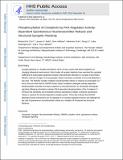| dc.contributor.author | Cho, Richard W. | |
| dc.contributor.author | Buhl, Lauren Kaye | |
| dc.contributor.author | Volfson, Dina | |
| dc.contributor.author | Tran, Adrienne L. | |
| dc.contributor.author | Akbergenova, Yulia | |
| dc.contributor.author | Littleton, J. Troy | |
| dc.contributor.author | Li, Feng, 1968 Oct. 24- | |
| dc.date.accessioned | 2016-12-05T19:50:35Z | |
| dc.date.available | 2016-12-05T19:50:35Z | |
| dc.date.issued | 2015-11 | |
| dc.date.submitted | 2015-08 | |
| dc.identifier.issn | 08966273 | |
| dc.identifier.uri | http://hdl.handle.net/1721.1/105584 | |
| dc.description.abstract | Synaptic plasticity is a fundamental feature of the nervous system that allows adaptation to changing behavioral environments. Most studies of synaptic plasticity have examined the regulated trafficking of postsynaptic glutamate receptors that generates alterations in synaptic transmission.
Whether and how changes in the presynaptic release machinery contribute to neuronal plasticity is less clear. The SNARE complex mediates neurotransmitter release in response to presynaptic Ca[superscript 2+] entry. Here we show that the SNARE fusion clamp Complexin undergoes activity-dependent phosphorylation that alters the basic properties of neurotransmission in Drosophila. Retrograde signaling following stimulation activates PKA-dependent phosphorylation of the Complexin Cterminus
that selectively and transiently enhances spontaneous release. Enhanced spontaneous release is required for activity-dependent synaptic growth. These data indicate that SNAREdependent fusion mechanisms can be regulated in an activity-dependent manner and highlight the key role of spontaneous neurotransmitter release as a mediator of functional and structural plasticity. | en_US |
| dc.description.sponsorship | JPB Foundation | en_US |
| dc.description.sponsorship | National Institutes of Health (U.S.) (Grants NS064750, NS40296 and MH104536) JPB Foundation | en_US |
| dc.language.iso | en_US | |
| dc.publisher | Elsevier/Cell Press | en_US |
| dc.relation.isversionof | http://dx.doi.org/10.1016/j.neuron.2015.10.011 | en_US |
| dc.rights | Creative Commons Attribution-NonCommercial-NoDerivs License | en_US |
| dc.rights.uri | http://creativecommons.org/licenses/by-nc-nd/4.0/ | en_US |
| dc.source | PMC | en_US |
| dc.title | Phosphorylation of Complexin by PKA Regulates Activity-Dependent Spontaneous Neurotransmitter Release and Structural Synaptic Plasticity | en_US |
| dc.type | Article | en_US |
| dc.identifier.citation | Cho, Richard W. et al. “Phosphorylation of Complexin by PKA Regulates Activity-Dependent Spontaneous Neurotransmitter Release and Structural Synaptic Plasticity.” Neuron 88.4 (2015): 749–761. | en_US |
| dc.contributor.department | Massachusetts Institute of Technology. Department of Biology | en_US |
| dc.contributor.department | Massachusetts Institute of Technology. Department of Brain and Cognitive Sciences | en_US |
| dc.contributor.department | Picower Institute for Learning and Memory | en_US |
| dc.contributor.mitauthor | Cho, Richard W. | |
| dc.contributor.mitauthor | Buhl, Lauren Kaye | |
| dc.contributor.mitauthor | Volfson, Dina | |
| dc.contributor.mitauthor | Tran, Adrienne L. | |
| dc.contributor.mitauthor | Akbergenova, Yulia | |
| dc.contributor.mitauthor | Littleton, J. Troy | |
| dc.relation.journal | Neuron | en_US |
| dc.eprint.version | Author's final manuscript | en_US |
| dc.type.uri | http://purl.org/eprint/type/JournalArticle | en_US |
| eprint.status | http://purl.org/eprint/status/PeerReviewed | en_US |
| dspace.orderedauthors | Cho, Richard W.; Buhl, Lauren K.; Volfson, Dina; Tran, Adrienne; Li, Feng; Akbergenova, Yulia; Littleton, J. Troy | en_US |
| dspace.embargo.terms | N | en_US |
| dc.identifier.orcid | https://orcid.org/0000-0001-5576-2887 | |
| mit.license | PUBLISHER_CC | en_US |
